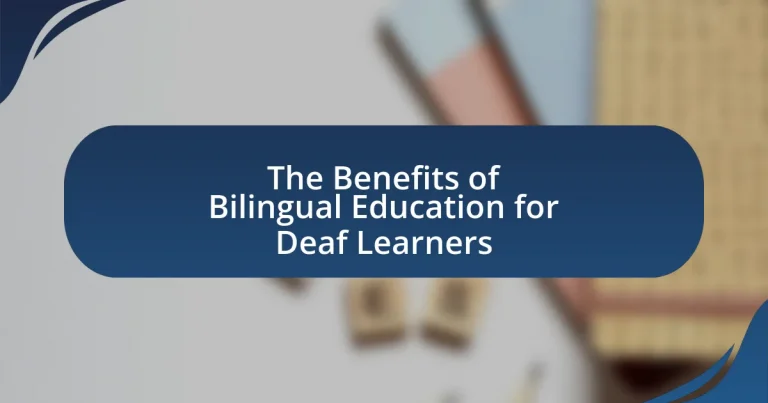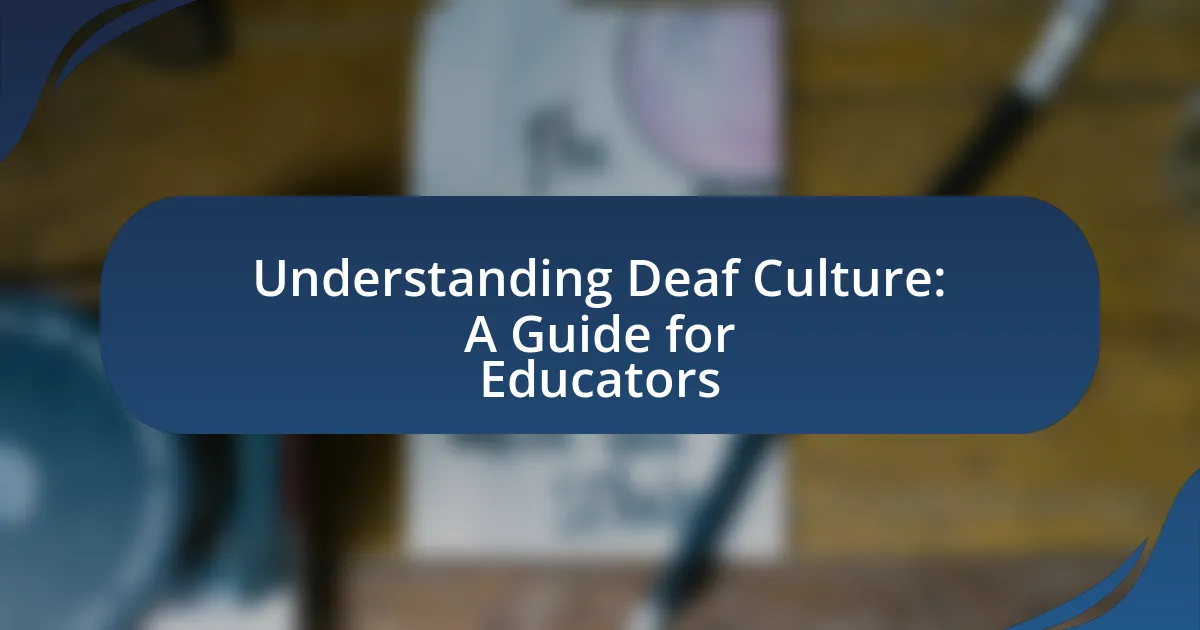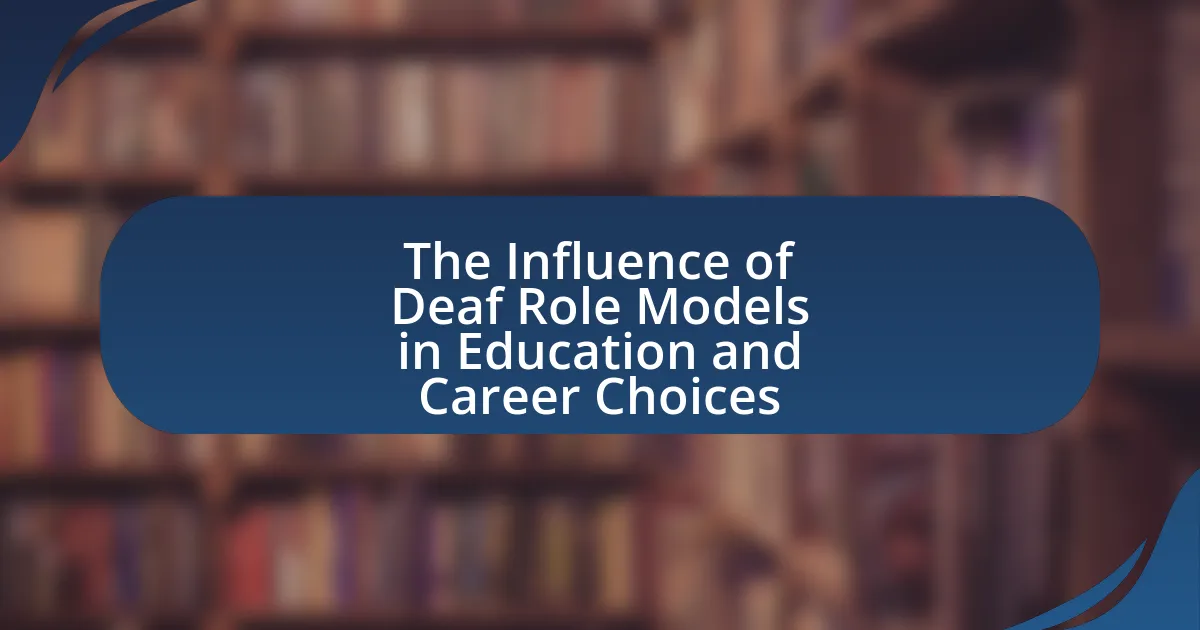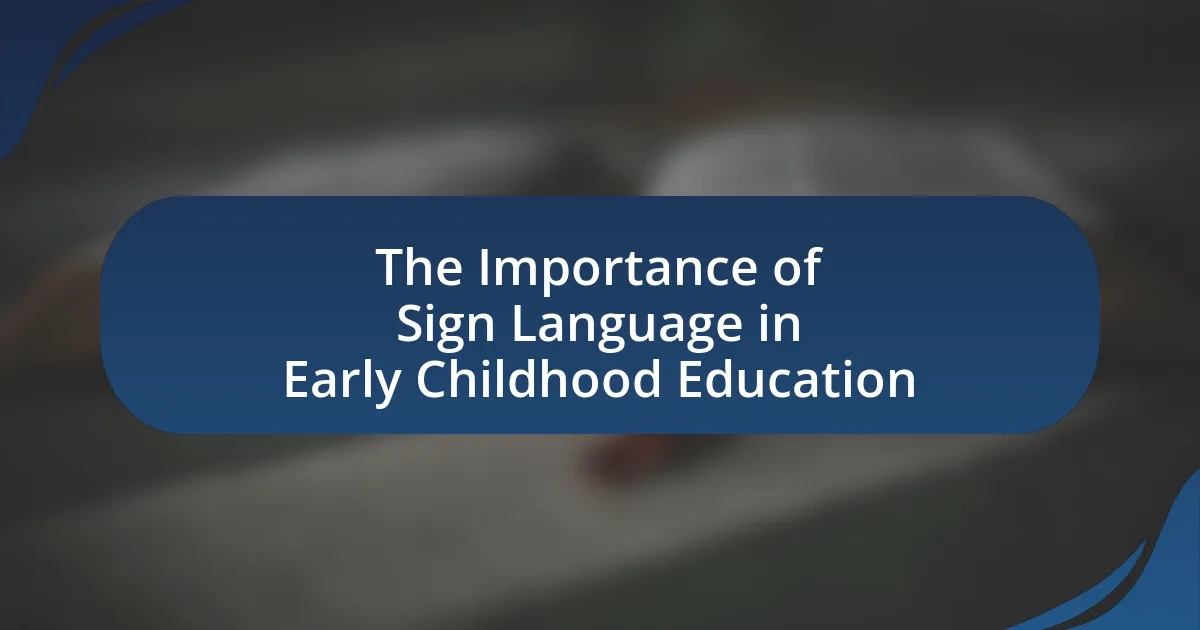Bilingual education for deaf learners is an instructional approach that utilizes both sign language and a spoken or written language to enhance learning and communication. This method is shown to improve cognitive development, literacy skills, and academic performance among deaf students, while also fostering social integration and cultural identity. The article explores the differences between bilingual education for deaf and hearing learners, the languages typically involved, and the cognitive and social benefits of this educational approach. It also addresses the challenges faced in implementing bilingual education and offers strategies for educators to enhance its effectiveness, highlighting the importance of policy changes and technological innovations in supporting deaf learners.
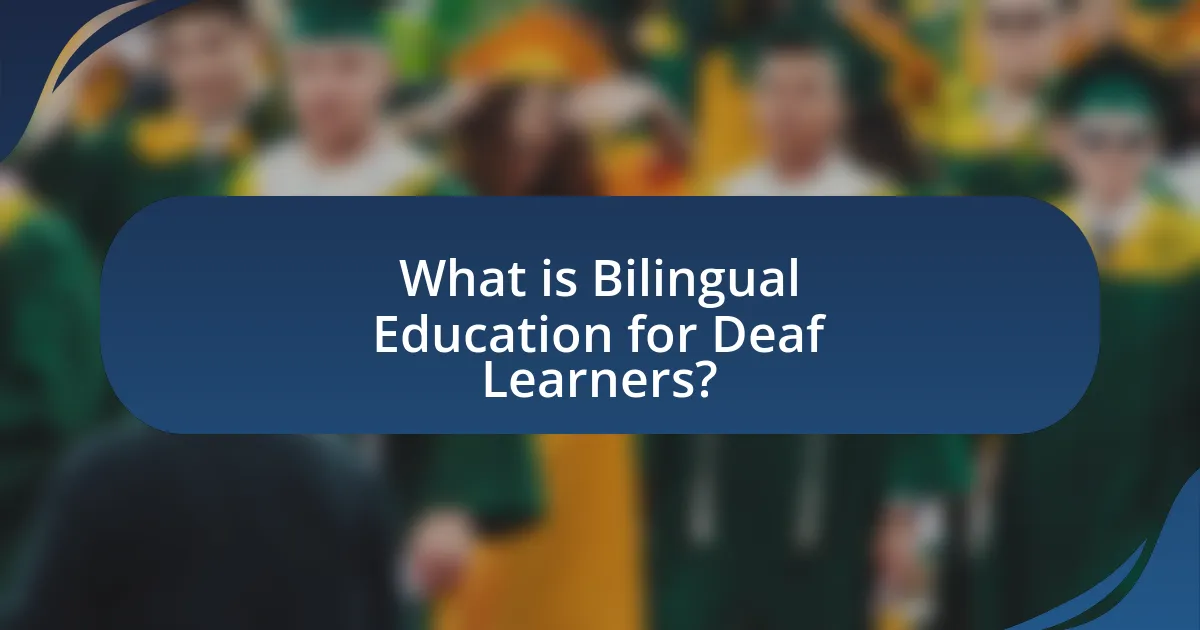
What is Bilingual Education for Deaf Learners?
Bilingual education for deaf learners is an instructional approach that uses both sign language and a spoken or written language to facilitate learning. This method recognizes the importance of sign language as a primary mode of communication for deaf individuals while also providing access to a spoken or written language, enhancing cognitive and linguistic development. Research indicates that bilingual education can improve academic outcomes, social skills, and cultural identity among deaf learners, as it allows them to engage fully in both their deaf and hearing communities.
How does bilingual education differ for deaf learners compared to hearing learners?
Bilingual education for deaf learners differs significantly from that for hearing learners primarily in the mode of communication used for instruction. Deaf learners often utilize sign language as their primary language, which serves as a bridge to learning a second language, typically a spoken or written language, while hearing learners primarily engage with spoken language for both their first and second languages. Research indicates that deaf students benefit from bilingual education that incorporates sign language, as it enhances their cognitive development and literacy skills, evidenced by studies showing improved reading comprehension and academic performance when sign language is used alongside written language instruction.
What languages are typically involved in bilingual education for deaf learners?
Bilingual education for deaf learners typically involves sign language and a spoken or written language, such as English or Spanish. Sign language serves as the primary mode of communication, while the spoken or written language is taught to enhance literacy and academic skills. Research indicates that using both languages supports cognitive development and improves educational outcomes for deaf students, as evidenced by studies showing higher literacy rates among those who receive bilingual instruction compared to those who do not.
How is sign language integrated into bilingual education programs?
Sign language is integrated into bilingual education programs by using it as a primary mode of communication alongside spoken language, facilitating access to both languages for Deaf learners. This integration allows students to develop proficiency in sign language while simultaneously acquiring skills in the spoken language of their community. Research indicates that bilingual education programs that incorporate sign language improve literacy outcomes and cognitive development for Deaf students, as they can engage with content in a language they fully understand. For instance, studies have shown that Deaf students in bilingual settings demonstrate better academic performance compared to those in traditional educational environments that do not utilize sign language.
Why is bilingual education important for deaf learners?
Bilingual education is important for deaf learners because it enhances their communication skills and cognitive development. By providing instruction in both sign language and written/spoken language, deaf learners can access a broader range of information and express themselves more effectively. Research indicates that bilingual education supports better academic outcomes, as evidenced by studies showing that deaf students in bilingual programs perform better in literacy and other subjects compared to those in monolingual settings. This dual-language approach fosters a deeper understanding of both languages, promoting cultural identity and social integration, which are crucial for the overall development of deaf learners.
What cognitive benefits does bilingual education provide to deaf learners?
Bilingual education provides cognitive benefits to deaf learners by enhancing their executive functioning skills, such as problem-solving, multitasking, and cognitive flexibility. Research indicates that bilingual individuals often outperform monolingual peers in tasks requiring these skills due to the constant practice of switching between languages and managing different linguistic systems. A study by Bialystok (2011) found that bilingualism contributes to improved attention control and better performance on tasks that require inhibition of distractions, which is particularly beneficial for deaf learners who navigate multiple communication modalities.
How does bilingual education enhance communication skills for deaf learners?
Bilingual education enhances communication skills for deaf learners by providing them with access to both sign language and spoken language, facilitating better understanding and expression. This dual-language approach allows deaf learners to develop proficiency in sign language, which is crucial for their social interactions and cultural identity, while also improving their literacy and comprehension in spoken language. Research indicates that bilingual education can lead to higher academic achievement and improved cognitive skills, as it encourages critical thinking and problem-solving abilities. For instance, a study published in the Journal of Deaf Studies and Deaf Education found that deaf students in bilingual programs demonstrated significantly better reading skills compared to those in monolingual settings, highlighting the effectiveness of bilingual education in enhancing overall communication capabilities.
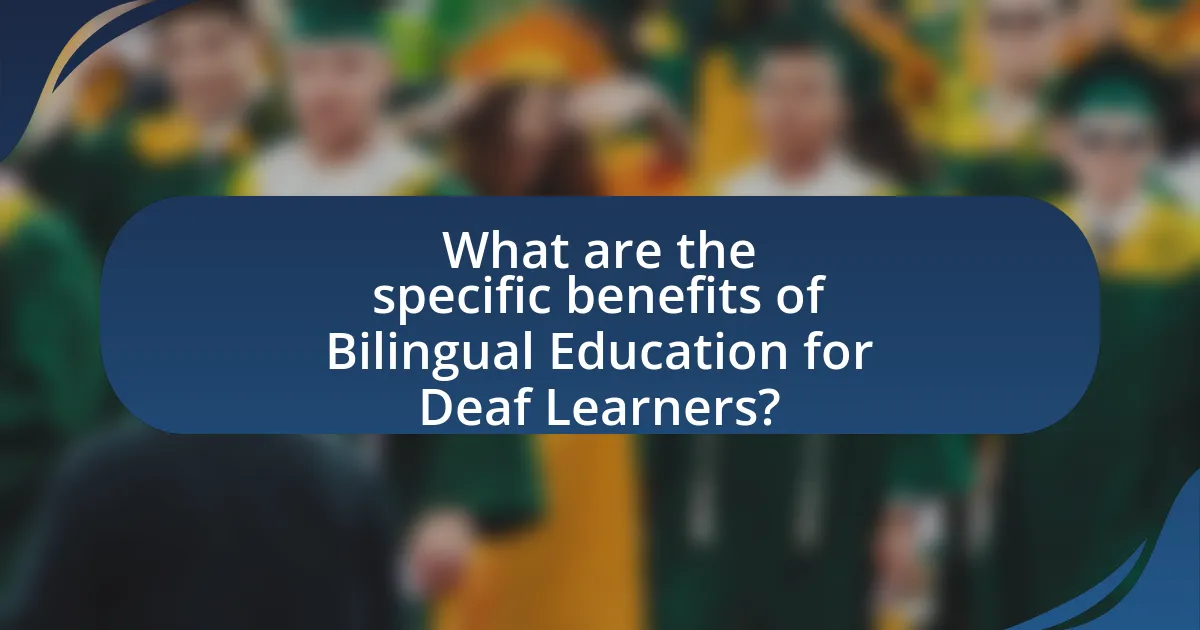
What are the specific benefits of Bilingual Education for Deaf Learners?
Bilingual education for deaf learners provides enhanced cognitive development, improved language skills, and greater academic achievement. Research indicates that deaf students who engage in bilingual education, which includes both sign language and written/spoken language, demonstrate better comprehension and retention of information compared to those who receive instruction solely in one language. A study published in the Journal of Deaf Studies and Deaf Education found that bilingual approaches lead to higher literacy rates and better overall academic performance among deaf learners. Additionally, bilingual education fosters social inclusion and cultural identity, allowing deaf students to connect with both the deaf community and the hearing world effectively.
How does bilingual education improve academic performance for deaf learners?
Bilingual education improves academic performance for deaf learners by providing them with access to both sign language and written language, enhancing their communication skills and cognitive development. Research indicates that deaf students who engage in bilingual education demonstrate better literacy skills and overall academic achievement compared to those in monolingual settings. For instance, a study by Lang et al. (2018) published in the Journal of Deaf Studies and Deaf Education found that deaf learners in bilingual programs scored significantly higher on standardized reading assessments than their peers in traditional educational environments. This improvement is attributed to the dual language exposure, which fosters a deeper understanding of concepts and promotes critical thinking skills essential for academic success.
What evidence supports the academic advantages of bilingual education?
Bilingual education provides significant academic advantages, particularly for deaf learners, as evidenced by improved cognitive skills, enhanced literacy, and better academic performance. Research conducted by the National Center for Education Statistics indicates that bilingual students often outperform their monolingual peers in standardized tests, demonstrating higher levels of reading comprehension and mathematical problem-solving abilities. Additionally, a study published in the Journal of Deaf Studies and Deaf Education found that deaf students in bilingual programs showed greater proficiency in both their first and second languages, leading to improved overall academic outcomes. These findings underscore the effectiveness of bilingual education in fostering academic success among deaf learners.
How do bilingual programs affect literacy development in deaf learners?
Bilingual programs positively affect literacy development in deaf learners by providing access to both sign language and written language, which enhances their overall language skills. Research indicates that deaf learners who participate in bilingual education demonstrate improved reading comprehension and writing abilities compared to those in monolingual settings. A study by Mayberry and Eichen (2000) found that early exposure to sign language significantly correlates with better literacy outcomes, as it allows deaf learners to develop a strong linguistic foundation. This dual-language approach fosters cognitive flexibility and supports the transfer of skills between languages, ultimately leading to greater academic success in literacy.
What social benefits arise from bilingual education for deaf learners?
Bilingual education for deaf learners fosters enhanced social integration and communication skills. This educational approach allows deaf students to acquire both sign language and spoken language, facilitating better interaction with peers and the hearing community. Research indicates that bilingual education promotes cultural awareness and identity among deaf learners, leading to increased self-esteem and social confidence. For instance, a study by the National Deaf Center on Postsecondary Outcomes highlights that deaf individuals who are proficient in both languages experience improved social relationships and community involvement. These benefits underscore the importance of bilingual education in supporting the social development of deaf learners.
How does bilingual education foster social inclusion for deaf learners?
Bilingual education fosters social inclusion for deaf learners by providing them with access to both sign language and spoken language, which enhances their communication skills and social interactions. This dual-language approach allows deaf learners to engage more fully with their peers, educators, and the broader community, reducing feelings of isolation. Research indicates that deaf students in bilingual programs demonstrate improved social skills and higher self-esteem, as they can communicate effectively in diverse settings. For instance, a study published in the Journal of Deaf Studies and Deaf Education found that bilingual education positively impacts the social integration of deaf students, enabling them to form meaningful relationships and participate actively in social activities.
What role does bilingual education play in cultural identity for deaf learners?
Bilingual education plays a crucial role in shaping the cultural identity of deaf learners by providing them with access to both sign language and spoken language, which fosters a sense of belonging within both the Deaf community and the hearing world. This dual-language approach allows deaf learners to engage with their cultural heritage through sign language, which is integral to Deaf culture, while also equipping them with the skills to navigate mainstream society. Research indicates that bilingual education enhances self-esteem and cultural pride among deaf learners, as it validates their identity and promotes linguistic diversity. Studies, such as those conducted by the National Deaf Center on Postsecondary Outcomes, show that deaf individuals who receive bilingual education are more likely to develop a strong cultural identity and achieve better academic outcomes.
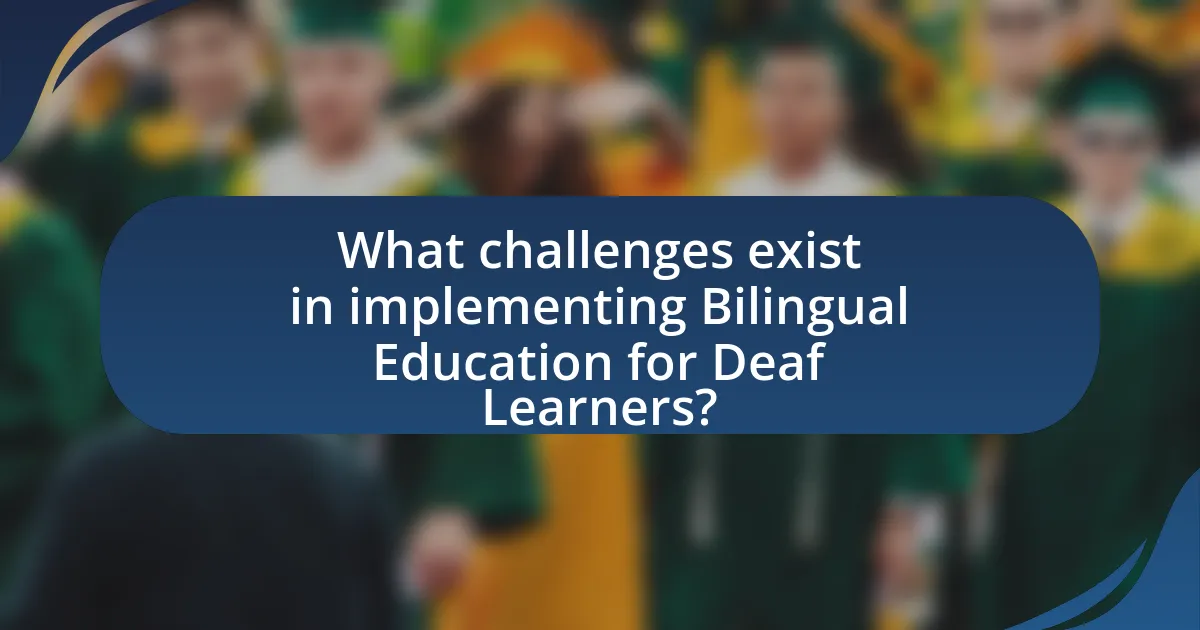
What challenges exist in implementing Bilingual Education for Deaf Learners?
Implementing Bilingual Education for Deaf Learners faces several challenges, including a lack of qualified educators proficient in both sign language and the spoken/written language, limited resources for developing appropriate curricula, and societal misconceptions about the capabilities of deaf individuals. Research indicates that many teachers lack the necessary training to effectively teach in a bilingual environment, which can hinder the educational experience. Additionally, funding constraints often limit access to materials and programs that support bilingual education, making it difficult to create an inclusive learning environment. Furthermore, the stigma surrounding deafness can lead to resistance from parents and communities, impacting enrollment and support for bilingual programs.
What barriers do educators face in bilingual education for deaf learners?
Educators face several barriers in bilingual education for deaf learners, primarily including a lack of resources, insufficient training, and communication challenges. The lack of resources often manifests in inadequate access to bilingual materials and technology that support both sign language and written language instruction. Insufficient training for educators in both deaf education and bilingual methodologies limits their ability to effectively teach deaf learners in a bilingual context. Communication challenges arise from the diverse language backgrounds of deaf learners, which can complicate the implementation of a cohesive bilingual curriculum. These barriers hinder the effectiveness of bilingual education programs, as evidenced by studies indicating that well-resourced and trained educators significantly improve learning outcomes for deaf students.
How can schools overcome these barriers to provide effective bilingual education?
Schools can overcome barriers to provide effective bilingual education by implementing comprehensive training programs for educators, ensuring access to appropriate resources, and fostering a supportive community environment. Comprehensive training equips teachers with the necessary skills to effectively teach in both languages, which is essential for the success of bilingual education. Research indicates that professional development focused on bilingual methodologies significantly enhances teaching effectiveness (García & Wei, 2014). Additionally, providing access to resources such as bilingual materials and technology supports diverse learning needs, facilitating better engagement and understanding among deaf learners. Finally, fostering a supportive community environment encourages collaboration among families, educators, and the broader community, which is crucial for reinforcing bilingual education’s benefits. Studies show that community involvement positively impacts student outcomes in bilingual settings (Turnbull et al., 2015).
What strategies can enhance the effectiveness of bilingual education for deaf learners?
Implementing visual aids and sign language as primary modes of instruction can significantly enhance the effectiveness of bilingual education for deaf learners. Research indicates that incorporating visual elements, such as images, videos, and diagrams, supports comprehension and retention of information, while sign language facilitates communication and understanding of complex concepts. A study by the National Deaf Center on Postsecondary Outcomes found that students who engaged in bilingual education programs that utilized both American Sign Language and English demonstrated improved academic performance and social skills compared to those in monolingual settings. Additionally, fostering a culturally responsive environment that values both languages promotes a sense of belonging and identity among deaf learners, further contributing to their educational success.
How can technology be utilized to support bilingual education for deaf learners?
Technology can be utilized to support bilingual education for deaf learners through the use of visual aids, interactive software, and communication tools. Visual aids, such as videos with sign language interpretation, enhance comprehension of both languages by providing contextual cues. Interactive software, like language learning apps designed for deaf users, allows for personalized learning experiences that cater to individual needs. Communication tools, such as real-time captioning and video conferencing platforms, facilitate interaction between deaf learners and educators, promoting engagement in both languages. These technological resources have been shown to improve language acquisition and literacy skills among deaf students, as evidenced by studies indicating that access to multimodal learning environments significantly enhances educational outcomes.
What best practices should educators follow in bilingual education for deaf learners?
Educators should implement a bilingual approach that integrates both sign language and spoken language to support deaf learners effectively. This practice acknowledges the importance of sign language as a primary mode of communication, which enhances cognitive development and language acquisition. Research indicates that bilingual education improves literacy skills among deaf students, as evidenced by a study published in the Journal of Deaf Studies and Deaf Education, which found that students exposed to both languages demonstrated higher reading comprehension levels compared to those who were not. Additionally, educators should create a culturally responsive curriculum that reflects the experiences and identities of deaf learners, fostering a sense of belonging and engagement. Regular assessments and individualized instruction tailored to each learner’s needs further enhance educational outcomes, ensuring that all students can thrive in a bilingual environment.
What are the future directions for Bilingual Education for Deaf Learners?
Future directions for Bilingual Education for Deaf Learners include the integration of technology to enhance language acquisition and the development of culturally relevant curricula. Research indicates that incorporating digital tools, such as mobile applications and online resources, can facilitate bilingual learning by providing interactive and engaging content tailored to Deaf learners’ needs. Additionally, fostering collaboration between educators, families, and the Deaf community is essential for creating inclusive educational environments that respect and promote both sign language and written language proficiency. Studies show that such collaborative approaches lead to improved academic outcomes and social integration for Deaf students.
How can policy changes improve bilingual education for deaf learners?
Policy changes can improve bilingual education for deaf learners by ensuring equitable access to resources and tailored instructional strategies. For instance, implementing policies that mandate the inclusion of sign language in educational curricula can enhance communication and comprehension for deaf students. Research indicates that bilingual education, which incorporates both sign language and spoken language, leads to better academic outcomes and social integration for deaf learners. A study by the National Deaf Center on Postsecondary Outcomes found that students who received bilingual education were more likely to pursue higher education and achieve better employment outcomes. Thus, effective policy changes can create a supportive framework that fosters bilingual proficiency and academic success for deaf learners.
What innovations are emerging in bilingual education for deaf learners?
Innovations in bilingual education for deaf learners include the integration of technology, such as mobile applications and virtual reality, to enhance language acquisition and engagement. These tools facilitate immersive learning experiences, allowing deaf students to interact with both sign language and written language in dynamic ways. Research indicates that using augmented reality can improve vocabulary retention and comprehension among deaf learners, as evidenced by studies showing increased engagement and understanding when visual and interactive elements are incorporated into lessons. Additionally, the development of bilingual curricula that emphasize cultural relevance and community involvement has been shown to foster a more inclusive learning environment, promoting both linguistic and social development.
What practical tips can enhance Bilingual Education for Deaf Learners?
To enhance Bilingual Education for Deaf Learners, educators should implement visual aids, such as pictures and videos, to support language comprehension. Research indicates that visual learning significantly benefits Deaf students, as it aligns with their primary mode of communication, which is often sign language. Additionally, incorporating interactive activities, like role-playing and group discussions, fosters engagement and practical language use. Studies show that active participation enhances language retention and fluency among Deaf learners. Furthermore, providing access to both sign language and written language resources ensures that students develop proficiency in both languages, which is crucial for their academic success.
